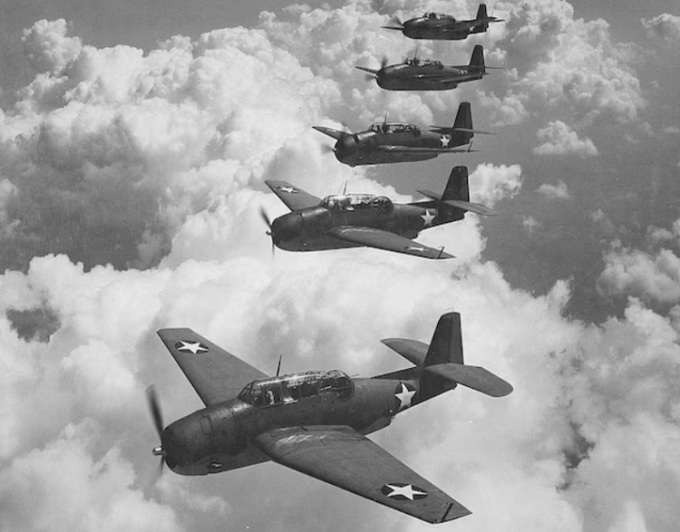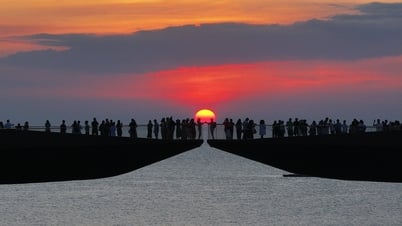Many ships and planes have disappeared without a trace in the Bermuda Triangle area bordering Miami, Bermuda, and Puerto Rico, and the cause of the disappearances remains a mystery.

Navy pilots flying an Avenger aircraft on a bombing training mission before it went missing. Photo: National Geographic
On a sunny day nearly 80 years ago, five US Navy planes took off from a Florida base on a routine training mission called Flight 19, but no one ever saw the planes or their pilots again. The Bermuda Triangle is an area surrounded by Miami, Bermuda, and Puerto Rico. While there are no statistics, over the past decade, many ships and planes have disappeared without a trace, according to National Geographic .
The area’s unusual features have been noted in the past. Christopher Columbus wrote in his diary about strange compass readings in the area. But the area remained nameless until August 2021, when Vincent Gaddis coined the term Bermuda Triangle to refer to the disappearance of Flight 19.
Many bizarre theories have emerged to explain what happened to the people. Their disappearance and the vehicle have been attributed to sea monsters, giant squids, or extraterrestrials. Alien abductions, the existence of dimensions created by an unknown species, and the phenomenon of “sea bloating,” caused by large amounts of trapped methane suddenly spewing out, have also been implicated. However, experts say the reality is much more prosaic. They say harsh natural conditions, human error, engineering or design skills, and bad luck can sometimes explain many disappearances.
The Disappearance of Flight 19
The Bermuda Triangle legend will forever be associated with the fateful flight that took place on December 5, 1945. Flight 17 took off from the US Naval Air Station in Fort Lauderdale, Florida. Five TBM Avenger Torpedo Bombers carrying 14 people took off at 2:10 p.m. that day on a routine maritime training mission. Under the command of Lieutenant Charles Taylor, their objective was to fly a triangular route divided into three legs and practice bombing the Hen and Chickens Reef.
In an era before satellite navigation became a common navigation tool, Taylor became lost shortly after dropping his bombs. Pilots flying over water relied on compasses to determine how long they were flying in a particular direction and at what speed. Both compasses in Taylor’s plane were malfunctioning. In-flight communications indicated that he was not wearing a watch and that there were no landmarks in the ocean.
The planes flew in one direction and then veered off as the mild weather of the day turned to stormy weather in the evening. Taylor planned that as soon as the first plane’s fuel level dropped below 381, all five planes would crash-land in the ocean. The Avengers were known for being extremely durable, built like tanks, according to Mark Evans, a historian at the Naval Aviation History Branch of the Naval Historical Institute. They were also heavy, weighing more than 10,000 pounds empty. When they landed, the Avengers didn’t dive too hard or fast.
The chances of anyone surviving the rough seas were slim. The odds of surviving the night in the cold water were even lower. The wreckage would likely sink quickly to the bottom of the ocean. However, in a massive search on land and sea, authorities found neither the pilot nor the plane. In addition, a rescue plane disappeared with its 13-man crew. In the Navy's final report, the pilot was blamed for the disappearance of Flight 19. After protests from the Taylor family and several revisions, the ruling was changed to "cause or reasons unknown."
Grave in the Atlantic
The Bermuda Triangle has several unusual features. It is one of only two places in the world where true north and magnetic north are aligned, which can cause compass readings to be inaccurate. It is also home to some of the world's deepest underwater trenches. Wreckage from sunken vessels can fall into watery graves several kilometers below the surface. Much of the seafloor in the Bermuda Triangle is 5,791 meters deep. Near the southern tip of the triangle, the Puerto Rico Trench is 8,229 meters below sea level.
Shallow coral reefs and rugged rocks line the continental shelf. Strong currents flowing over the reefs often pose a threat to mariners, according to the Coast Guard. Then there’s the weather. The biggest problem in the area is frequent storms, said Dave Feit, chief marine forecaster at the National Oceanic and Atmospheric Administration’s Ocean Prediction Center.
The Gulf Stream, which moves along the western edge of the triangle, may be a factor. The Gulf Stream is like a 40- to 50-mile-wide river that circulates in the North Atlantic. Warm water and a 2.3- to 4.5-mile-per-hour current can create weather patterns that lead to unexpectedly high waves. If a wave is 8 feet (2.4 m) outside the Gulf Stream, it can be two to three times higher inside the current. Sailors can sometimes detect the Gulf Stream by the storm clouds overhead. The Coast Guard has also noted that unpredictable Caribbean-Atlantic storms can create waterspouts, which can be disastrous for pilots and mariners.
An Khang (According to National Geographic )
Source link




































































































Comment (0)